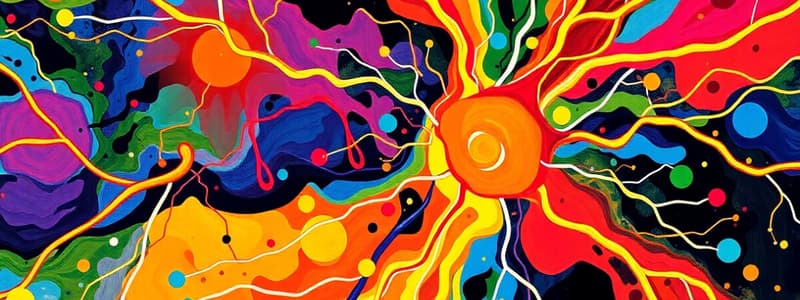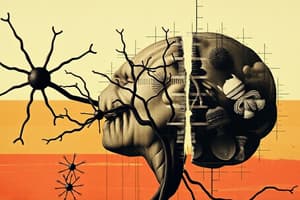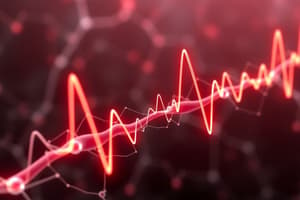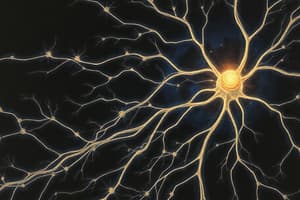Podcast
Questions and Answers
Which of the following is NOT a primary function of the nervous system?
Which of the following is NOT a primary function of the nervous system?
- Sensory
- Motor
- Integrative
- Digestive (correct)
Neurons are not electrically excitable.
Neurons are not electrically excitable.
False (B)
What is the term used for a nerve impulse in neurons?
What is the term used for a nerve impulse in neurons?
action potential
The function of integrating sensory information and making decisions falls under the __________ function of the nervous system.
The function of integrating sensory information and making decisions falls under the __________ function of the nervous system.
Match the following functions of the nervous system with their descriptions:
Match the following functions of the nervous system with their descriptions:
What is a key characteristic of graded potentials?
What is a key characteristic of graded potentials?
Action potentials can occur at any membrane potential.
Action potentials can occur at any membrane potential.
Name the two phases of an action potential.
Name the two phases of an action potential.
Graded potentials can be summed together to increase their ______.
Graded potentials can be summed together to increase their ______.
Match the following types of potentials with their characteristics:
Match the following types of potentials with their characteristics:
What is the amplitude range for graded potentials?
What is the amplitude range for graded potentials?
Graded potentials always consist of a depolarizing phase followed by a repolarizing phase.
Graded potentials always consist of a depolarizing phase followed by a repolarizing phase.
What are the three factors that affect the propagation speed of action potentials?
What are the three factors that affect the propagation speed of action potentials?
The process by which action potentials travel from the trigger zone to the axon terminals is called ______.
The process by which action potentials travel from the trigger zone to the axon terminals is called ______.
Match the following factors affecting propagation speed with their descriptions:
Match the following factors affecting propagation speed with their descriptions:
What is the primary function of gap junctions in electrical synapses?
What is the primary function of gap junctions in electrical synapses?
Chemical synapses allow two-way transfer of information between neurons.
Chemical synapses allow two-way transfer of information between neurons.
What type of potential is created by the binding of neurotransmitters that causes depolarization in the postsynaptic neuron?
What type of potential is created by the binding of neurotransmitters that causes depolarization in the postsynaptic neuron?
Neurotransmitter removal from the synaptic cleft can occur through __________ or uptake into cells.
Neurotransmitter removal from the synaptic cleft can occur through __________ or uptake into cells.
Match the type of receptor to its characteristic:
Match the type of receptor to its characteristic:
Flashcards
Homeostasis and nervous system
Homeostasis and nervous system
The nervous system helps maintain a stable internal environment by detecting and responding to changes within the body.
Divisions of the nervous system
Divisions of the nervous system
The nervous system is divided into the central nervous system (CNS) and the peripheral nervous system (PNS).
Functions of the nervous system
Functions of the nervous system
The nervous system gathers information from the environment (sensory), processes it (integrative), and sends instructions to various organs (motor).
Components of nervous tissue
Components of nervous tissue
Signup and view all the flashcards
What are neurons?
What are neurons?
Signup and view all the flashcards
Graded Potential Amplitude
Graded Potential Amplitude
Signup and view all the flashcards
Graded Potential Summation
Graded Potential Summation
Signup and view all the flashcards
Action Potential
Action Potential
Signup and view all the flashcards
Action Potential Threshold
Action Potential Threshold
Signup and view all the flashcards
Na+ and K+ Channels in Action Potentials
Na+ and K+ Channels in Action Potentials
Signup and view all the flashcards
Synapse
Synapse
Signup and view all the flashcards
Electrical Synapse
Electrical Synapse
Signup and view all the flashcards
Chemical Synapse
Chemical Synapse
Signup and view all the flashcards
Excitatory Postsynaptic Potential (EPSP)
Excitatory Postsynaptic Potential (EPSP)
Signup and view all the flashcards
Inhibitory Postsynaptic Potential (IPSP)
Inhibitory Postsynaptic Potential (IPSP)
Signup and view all the flashcards
Action Potential (AP)
Action Potential (AP)
Signup and view all the flashcards
Amplitude of an Action Potential
Amplitude of an Action Potential
Signup and view all the flashcards
Propagation of Action Potentials
Propagation of Action Potentials
Signup and view all the flashcards
Saltatory Conduction
Saltatory Conduction
Signup and view all the flashcards
Factors Affecting Propagation Speed
Factors Affecting Propagation Speed
Signup and view all the flashcards
Study Notes
Nervous Tissue Overview
- The nervous system keeps controlled conditions within limits for homeostasis.
- The nervous system has different branches.
- Various types of cells are found in nervous tissue.
Nervous System Overview
- The nervous system includes sensory neurons, interneurons, and motor neurons.
- Sensory neurons transmit impulses from receptors to the CNS.
- Interneurons are in the brain and spinal cord, processing information.
- Motor neurons transmit impulses from the CNS to effectors (muscles and glands).
Organization of the Nervous System
- The nervous system is organized into two main parts:
- Central Nervous System (CNS): Brain and spinal cord.
- Peripheral Nervous System (PNS): Cranial and spinal nerves, enteric plexuses, and sensory receptors.
- The PNS has sensory (afferent) and motor (efferent) divisions.
- Somatic nervous system controls skeletal muscles.
- Autonomic nervous system regulates smooth muscle, cardiac muscle, and glands (sympathetic and parasympathetic divisions).
- Enteric plexuses control digestive system.
Functions of the Nervous System
- Sensory: Detects changes through sensory receptors.
- Integrative: Analyzes sensory information, stores aspects, and makes decisions.
- Motor: Responds to stimuli via effectors (muscles and glands).
Neurons
- Electrically excitable.
- Nerve impulses are action potentials.
- Parts of a neuron include cell body, dendrites, axon, axon terminals, and synapses.
Neuron Structure and Classification
- Multipolar neurons (multiple processes).
- Bipolar neurons (two processes).
- Pseudounipolar neurons (one process).
- Sensory/afferent neurons, Motor/efferent neurons, interneurons/association neurons.
Neuroglia
- Support neurons.
- Not electrically excitable.
- Make up half the nervous system volume.
- Can multiply and divide.
- Six types (four in CNS, two in PNS).
Types of Neuroglia
- Astrocytes, Oligodendrocytes, Microglia, Ependymal cells (CNS).
- Satellite cells, and Schwann cells (PNS).
Myelination of Neurons
- Myelin sheath is produced by Schwann cells (PNS) and oligodendrocytes (CNS), surrounding axons for faster impulse propagation.
- Myelination increases speed of action potential propagation.
Gray Matter vs. White Matter
- Gray matter contains neuron cell bodies, dendrites, and synapses.
- White matter contains myelinated axons.
Electrical Signals in Neurons
- Excitable cells communicate via action potentials (APs) or graded potentials (GPs).
- Action potentials allow communication over short and long distances.
- Graded potentials allow communication over short distances.
Resting Membrane Potential
- The membrane of a non-conducting neuron is positive outside and negative inside.
- This is determined by unequal ion distribution, selective permeability to Na+ and K+, and active ion transport.
Graded Potentials
- Small deviations in resting membrane potential.
- Occur in response to the opening of mechanically-gated or ligand-gated ion channels.
- Strength depends on Stimulus strength.
- Summation can occur.
Action Potentials
- Rapidly occurring events that change the membrane potential.
- Two phases: Depolarization and Repolarization.
- All or none.
- Stimulus strength is important for eliciting potential.
- Influenced by factors like axon diameter and myelination.
- Absolute and Relative refractory periods.
Propagation of Action Potentials
- Action potentials travel from the trigger zone to the axon terminals.
- Propagation is how communication in the nervous system occurs.
- Two types of propagation: continuous and saltatory.
- Speed depends on axon diameter and myelination degree.
Factors Affecting Propagation Speed
- Axon diameter.
- Amount of myelination.
- Temperature.
Signal Transmission at Synapses
- Synapses are junctions between neurons or a neuron and an effector.
- Two types: Electrical Synapses and Chemical Synapses.
- Electrical: Gap junctions connect cells for rapid communication.
- Chemical: One-way transfer via neurotransmitters.
Events at the Synapse
- Action potential propagates to synaptic end bulb causing Calcium influx into the pre-synaptic neuron.
- Neurotransmitter release into the synaptic cleft..
- Neurotransmitter binds to receptor on the post-synaptic neuron.
- Post-synaptic potential is generated.
Postsynaptic Potentials
- Excitatory postsynaptic potential (EPSP) - depolarization
- Inhibitory postsynaptic potential (IPSP) - hyperpolarization.
- Postsynaptic neuron can receive multiple signals at once.
Neurotransmitter Receptors
- Types of receptors at chemical synapses: ionotropic and metabotropic.
- Ionotropic receptors directly bind to ion channels.
- Metabotropic receptors are coupled to other ion channels by G proteins.
Removal of Neurotransmitters
- Neurotransmitters are removed from the synaptic cleft by: Diffusion, Enzymatic degradation, Uptake into cells.
Summation
- Spatial summation: Multiple signals at the same time add together.
- Temporal summation: Multiple signals in rapid succession add together.
Neural Circuits
- Neural circuits are functional groups of neurons that process information.
- Types of circuits include: Simple series, Diverging, Converging, Reverberating, Parallel after-discharge.
Regeneration and Repair of Nervous Tissue
- Plasticity: The capacity of the nervous system to change based on experience.
- Regenerate: capability to replicate or repair.
- Repairs in the CNS are limited due to factors such as inhibitory influences from neuroglia and scar tissue formation.
- Repairs in PNS are possible if the cell body is intact, Schwann cells are functional, and scar tissue formation is not excessively rapid. Steps in the process include chromatolysis, Wallerian degeneration, and the formation of regenerating tubes.
Neural Disorders
- Multiple sclerosis: Autoimmune disease causing progressive demyelination of neurons.
- Depression: Several types, including major depression, dysthymia, bipolar depression, and seasonal affective disorder. (SAD).
- Other neural disorders include epilepsy and excitotoxicity. (caused by high levels of glutamate).
Neurotransmitters
- Small-molecule neurotransmitters: Acetylcholine, amino acids, biogenic amines, ATP, nitric oxide, and carbon monoxide.
- Neuropeptides: Substance P, enkephalins, endorphins, dynorphins, hypothalamic releasing and inhibiting hormones, angiotensin II, and cholecystokinin (CCK), and neuropeptide Y.
Studying That Suits You
Use AI to generate personalized quizzes and flashcards to suit your learning preferences.




